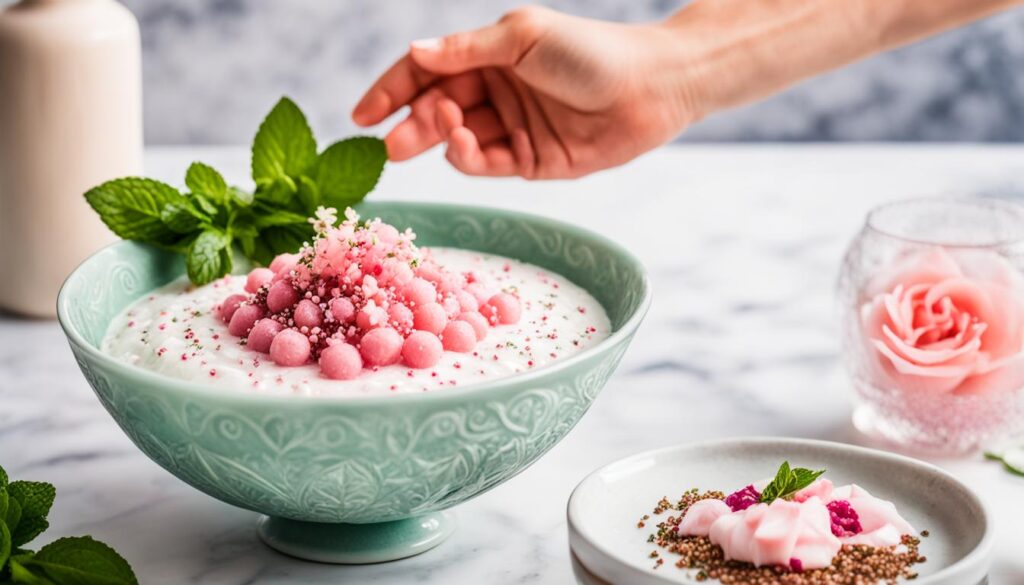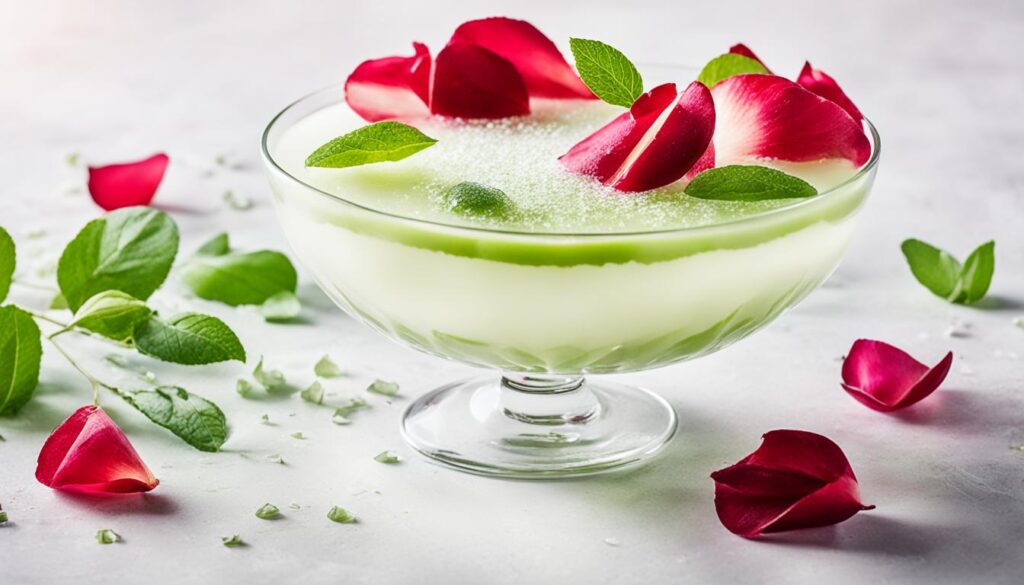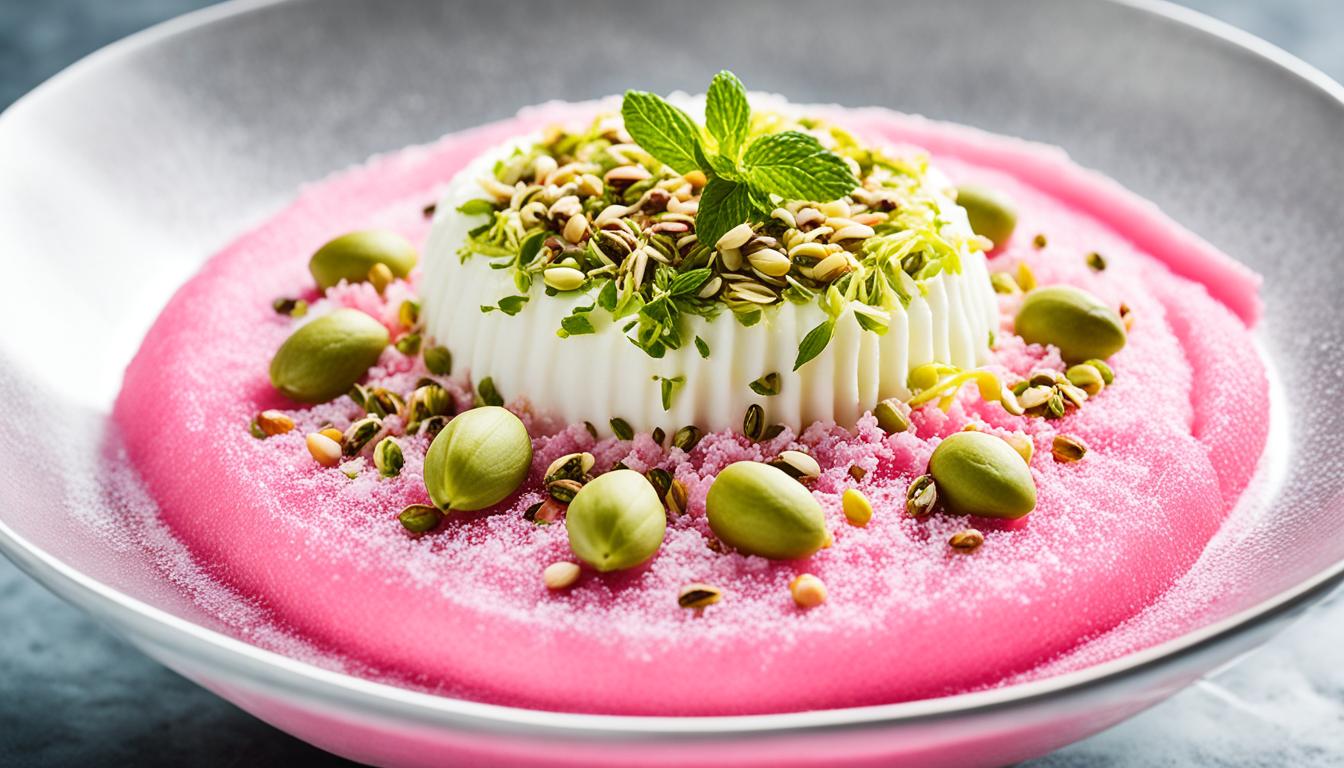Are you looking for a refreshing summer dessert that is both exotic and easy to make? Look no further than Faloodeh, a traditional Iranian dessert that combines frozen noodles with a sweet rose water syrup. It’s the perfect ice cream alternative that will transport your taste buds to another era.
- Faloodeh is a traditional Iranian dessert that combines frozen noodles with a sweet rose water syrup.
- It is a refreshing and exotic frozen treat, perfect for hot summer days.
- With its easy recipe, you can make homemade sorbet that rivals any store-bought version.
- Faloodeh has a long history in Persian culinary traditions and is a beloved dessert in Iran.
- Whether you’re a fan of traditional sweets or looking for a new and unique dessert, Faloodeh is sure to delight your taste buds.
The History of Faloodeh
Faloodeh, an ancient Persian dessert, has a fascinating history rooted in the icy treats of Persia. In ancient Persia, as early as 400 BCE, Persians were making, collecting, and storing ice even in the midst of the desert. They built impressive structures called yakhchāls to preserve the ice for various purposes, including making refreshing frozen beverages and treats.
The Persians’ mastery of ice preservation and their love for icy delicacies eventually led to the creation of what we now know as faloodeh. These early Persians crafted frozen sweets incorporating thin threads of noodles into a sweet rose water–flavored syrup that was cooled to a semi-frozen state. Faloodeh-type desserts gradually made their way to the Arab world after the Muslim conquest of Persia in the 7th century, and later spread to Sicily and the Indian subcontinent.
Today, faloodeh stands as a cherished dessert deeply rooted in Persian culinary traditions. It represents the ingenuity of ancient Persians in creating icy treats and their ability to preserve ice, even in the harshest environments. The history of faloodeh reflects the rich culinary heritage of Persia and the enduring appeal of this unique frozen delicacy.
Yakhchāls: Ice Preservation in Ancient Persia
One of the remarkable achievements of ancient Persia was the creation of yakhchāls. These structures demonstrated the Persians’ mastery in preserving ice, enabling them to enjoy a variety of icy treats even in the desert. Yakhchāls were built using traditional methods and natural elements to create an environment conducive to ice preservation.
“The yakhchāl was built as a round tower with a conical dome, which started underground and extended upwards to a height of 5-10 meters above the surface.”
The construction materials used, such as mud bricks and special mortar mixed with sand, allowed for optimal insulation, keeping the stored ice from melting for extended periods. The structures featured thick walls, small windows, and air vents designed to facilitate natural cooling and maintain a consistent temperature. Some yakhchāls also utilized windcatchers, architectural elements that enhanced airflow.
The ice harvested during the winter months was stored in yakhchāls, maintaining its frozen state throughout the year. The ice served many purposes, including the production of faloodeh and the creation of chilled beverages. The innovation and engineering behind yakhchāls is a testament to the ancient Persians’ ingenuity and their desire for icy treats even in the most challenging climates.
Making Faloodeh at Home
Making faloodeh at home is a rewarding experience. While the traditional method involves making fresh wheat-starch noodles, an easier and equally good alternative is to use mung bean noodles or glass noodles. These noodles, when cooked and frozen, turn snow-white and provide a delicate crunch to the faloodeh.
The essential ingredient in making authentic faloodeh is the rose water syrup. It can be easily made by combining sugar, water, and rose water. This fragrant syrup adds a floral aroma and sweetness that perfectly complements the noodles.
To prevent the mixture from freezing into a solid block of ice, light corn syrup can be added to the rose water syrup. This helps maintain the desired semi-frozen consistency of the faloodeh.
The homemade faloodeh can be prepared using an ice cream maker or made without one. If you have an ice cream maker, simply follow the manufacturer’s instructions to freeze the mixture into a luscious dessert.
“Making faloodeh at home allows us to have control over the ingredients and create an authentic and delicious treat.”
If you don’t have an ice cream maker, you can still enjoy homemade faloodeh by freezing the mixture in a shallow container. Every hour, take the container out of the freezer and scrape the frozen edges towards the center, breaking up any ice crystals. Repeat this process several times until the faloodeh achieves the desired consistency. This manual method may require a bit more time and effort but results in a delightful homemade faloodeh.
Here’s a step-by-step guide to making homemade faloodeh:
- Cook the alternative noodles, such as mung bean noodles or glass noodles, according to the package instructions.
- Prepare the rose water syrup by combining sugar, water, and rose water in a saucepan. Bring the mixture to a boil, stirring until the sugar is completely dissolved. Remove from heat and let it cool.
- Add light corn syrup to the cooled rose water syrup to ensure a slushy texture when frozen.
- Mix the cooked noodles and the rose water syrup together until well combined.
- Transfer the mixture to an ice cream maker or a shallow container for manual freezing.
- Follow the ice cream maker’s instructions to freeze the mixture or manually freeze it, breaking up ice crystals every hour until the desired consistency is achieved.
Now, you’re ready to enjoy your homemade faloodeh, a flavorful and refreshing dessert with the perfect balance of tender noodles and fragrant rose water syrup.
Comparison of Traditional and Alternative Noodles for Faloodeh
| Traditional Wheat-Starch Noodles | Alternative Noodles (Mung Bean or Glass Noodles) |
|---|---|
| Takes time and effort to make from scratch | Readily available and easy to cook |
| Has a slightly chewy texture | Turns snow-white and provides a delicate crunch |
| Requires specific ingredients like wheat starch | Offers a convenient alternative for those with dietary restrictions or limited access to wheat starch |
Serving and Enjoying Faloodeh
Faloodeh, a beloved Persian dessert, is traditionally served in individual bowls. To enhance the flavors and elevate the experience, it can be topped with various traditional toppings. Two popular choices are:
- Lime or Lemon Juice: A splash of freshly squeezed lime or lemon juice adds a tangy and refreshing flavor, perfectly balancing the sweetness of the dessert.
- Sour Cherry Syrup: Drizzling sour cherry syrup over the faloodeh imparts a fruity and slightly tart element, creating a delightful contrast to the icy treat.
The combination of these toppings with the delicate noodles and rose water syrup creates a unique blend of flavors and textures in each spoonful. As you enjoy your faloodeh, you’ll notice its slushy texture, which tends to melt faster than other frozen desserts. This transformation in your bowl allows the noodles to swim gracefully in the melted slush, enhancing the authentic faloodeh experience.

“The combination of these toppings with the delicate noodles and rose water syrup creates a unique blend of flavors and textures in each spoonful.”
Variations and Adaptations of Faloodeh
Faloodeh, like any beloved dessert, has seen various regional variations and adaptations over time. These unique twists on the traditional recipe bring new dimensions to the faloodeh experience and showcase the culinary creativity of different cultures. Let’s explore some of the popular variations:
Falooda: A Delightful Arab Version
In the Arab world, a version of faloodeh is known as falooda. This delightful adaptation incorporates additional ingredients to create a more complex flavor profile. Alongside the familiar rose water and noodles, falooda includes basil seeds, vermicelli, and milk. The infusion of these ingredients adds richness and texture, elevating the dessert to a whole new level.
Faludeh without Noodles: A Refreshing Twist
In some renditions of faloodeh, the noodles are left out, resulting in a unique variation that focuses on other ingredients. Instead of the noodles, these versions feature refreshing fruits like melons, which are sliced or pureed to mimic the noodle-like texture. The absence of noodles lends a lighter and fruit-forward quality to the dessert, making it a perfect choice for those seeking a different taste experience.

Apple Faludeh: A Twist from Israel
In Israel, faludeh undergoes a delightful transformation by replacing the traditional noodles with grated apples. Known as “faludeh sib,” this adaptation captures the essence of the original dessert while incorporating the natural sweetness and crisp texture of apples. Apple faludeh offers a refreshing and slightly tart twist, making it a unique treat ideal for apple enthusiasts.
Faludeh and Bastani: A Match Made in Heaven
Combining faloodeh with bastani, the beloved Persian ice cream, creates a heavenly dessert experience. This delightful union marries the delicate rose water flavors and refreshing textures of faloodeh with the rich and creamy goodness of bastani. The combination of the two iconic Persian delicacies creates a harmonious symphony of flavors that satisfies both the craving for a frozen treat and the desire for a traditional taste.
The Cultural Significance of Faloodeh
Faloodeh holds great cultural significance in Persian gatherings, playing a prominent role in traditional feasts and summer barbecues. Its presence on the dining table signifies the celebration of Persian culinary heritage and the preservation of cultural traditions.
One of the reasons faloodeh is treasured in Persian culture is its non-dairy nature. As a non-dairy dessert, it is a popular choice among those with dietary restrictions or preferences, allowing everyone to indulge in its unique flavors and textures. This inclusivity adds to its appeal and showcases its adaptability in catering to diverse tastes.
Faloodeh also represents the ingenuity of ancient Persians in creating icy treats and preserving ice in the desert. It serves as a testament to the resourcefulness and creativity of the Persian people, who mastered the art of keeping ice cool in yakhchals (icehouses) even in the hottest desert climates. This cultural innovation is woven into every spoonful of faloodeh, making it more than just a dessert but a reflection of the Persian spirit.
The Role of Faloodeh in Persian Gatherings
Faloodeh takes center stage in many Persian gatherings, adding a touch of nostalgia and a burst of refreshing flavors to the festivities. It is commonly served at traditional feasts, where families and friends gather to share a meal and celebrate special occasions. Its presence on the dessert table creates a sense of unity and connection, evoking memories of past gatherings and strengthening bonds.
During summer barbecues, faloodeh offers a delightful respite from the heat and serves as a perfect ending to a flavorful meal. Its cool, slushy texture and floral notes provide a refreshing and satisfying experience, leaving taste buds refreshed and satisfied.
Promoting Persian Culinary Heritage
Faloodeh showcases the rich culinary heritage of Persian cuisine and is a symbol of cultural pride. Passed down through generations, the recipe for faloodeh has remained largely unchanged, preserving the authenticity and tradition of this beloved dessert.
As Persian cuisine gains popularity around the world, faloodeh stands as an ambassador, introducing people to the unique flavors and textures of Persian desserts. Its presence on menus in Iranian restaurants and its inclusion in international food events contribute to the promotion and recognition of Persian culinary heritage on a global scale.
“Faloodeh represents our rich traditions and the ability to create incredible delicacies from simple ingredients. Its cultural significance cannot be understated.”
The Future of Faloodeh
Despite the passage of time, faloodeh continues to thrive as a dessert deeply rooted in Persian culture. It has secured its place on dining tables, and its popularity shows no signs of waning.
With its non-dairy nature, refreshing flavors, and symbolic value, faloodeh will remain cherished in Persian gatherings and continue to be an integral part of the Persian culinary heritage for generations to come.
Conclusion
In conclusion, faloodeh is a Persian frozen delicacy that has delighted taste buds for centuries. This timeless dessert offers a unique combination of flavors and textures, making it a refreshing treat, especially during hot summer days. Whether enjoying it at a Persian feast or making it at home, faloodeh provides a culinary experience that transports you to another era.
One of the highlights of faloodeh is the ability to customize the flavors and ingredients to your preference. By making faloodeh at home, you have control over the authenticity of the flavors and can experiment with different variations. This non-dairy dessert appeals to a wide range of palates and dietary restrictions, ensuring that everyone can savor its delights.
With its fascinating history and cultural significance, faloodeh is more than just a frozen dessert. It represents the innovative spirit of ancient Persians and their culinary heritage. The combination of delicate noodles, sweet rose water syrup, and traditional toppings creates a truly unforgettable experience for your taste buds.
So, whether you choose the traditional faloodeh or explore the various adaptations, brace yourself for a journey through time and taste with this Persian frozen delicacy. Let the unique flavors and textures of faloodeh enchant you and make it a part of your culinary repertoire. Discover the joy of faloodeh and indulge in a dessert that has stood the test of time.
